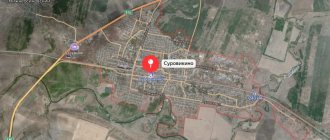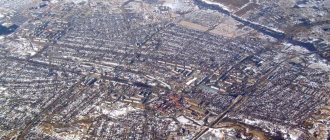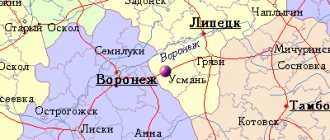For other places with the same name, see Grateful.
City in Stavropol Krai, Russia
| Grateful Grateful | |
| City [1] | |
| Flag Coat of arms | |
| Location Grateful | |
| Grateful Location Grateful Show map of Russia Grateful Blagodarny (Stavropol Territory) Show map of Stavropol Territory | |
| Coordinates: 45°06'N 43°27'E / 45.100°N W. 43.450 ° E. / 45,100; 43.450 Coordinates: 45°06'N 43°27'E. / 45.100 ° N. W. 43.450 ° E. / 45,100; 43,450 | |
| A country | Russia |
| Federal subject | Stavropol region [1] |
| Administrative region | Blagodarnensky district [1] |
| Town | Grateful |
| Based | 1782 |
| City status from | 1971 |
| Height | 160 m (520 ft) |
| population size (2010 Census) [2] | |
| • General | 32 725 |
| Administrative status | |
| • Capital from | Blagodarny district [1], Blagodarny |
| Municipal status | |
| • Municipal district | Blagodarnensky municipal district [3] |
| • Urban village | Urban settlement Blagodarny [3] |
| • Capital from | Blagodarny municipal district [4], urban-type settlement Blagodarny [3] |
| Timezone | UTC+3 (MSK[5]) |
| Postal code [6] | 356420 |
| OKTMO ID | 07610101001 |
Grateful
(Russian: Blagodarny) is a city and the administrative center of Blagodarnensky District in Stavropol Krai, Russia, located on the Mokraya Buyvola River (Kuma's tributary), 150 km (93 mi) east of Stavropol, the administrative center of the region.
Population: 32,725 (2010 census); [2] 34,500 (2002 census); [7] 27,828 (1989 census). [8] It was previously called Grateful
.
Links[edit]
Notes[edit]
- ^ abcde Resolution No. 63-p
- ^ a b Federal State Statistics Service (2011). “All-Russian Population Census 2010. Volume 1" [All-Russian Population Census 2010, vol. 1]. All-Russian Population Census 2010 [All-Russian Population Census 2010]
. Federal State Statistics Service. - ^ abcd Law No. 37-kz
- Law No. 88-kz
- "On the Calculation of Time". Official Internet portal of legal information
. June 3, 2011. Retrieved January 19, 2022. - Post office. Information and computing center of OASU RPO. ( Post office
).
Search for postal service objects ( postal Search for objects
) (in Russian) - ↑
Federal State Statistics Service of Russia (May 21, 2004).
“The population of Russia, the constituent entities of the Russian Federation as part of federal districts, urban settlements, settlements, settlements of 3 thousand or more people” [Population of Russia, its federal districts, federal districts, districts, urban settlements, rural settlements - administrative centers and rural settlements with a population of more than 3,000 people] (XLS). All-Russian Population Census 2002
. - “All-Union Population Census of 1989. The current population of union and autonomous republics, autonomous regions and districts, territories, negative phenomena, urban settlements and rural district centers” [All-Union Population Census of 1989: current population of union and autonomous republics, Autonomous regions and districts , territories, regions, districts, towns and villages performing the functions of district administrative centers. All-Union Population Census of 1989 [All-Union Population Census of 1989]
.
Institute of Demography of the National Research University: Higher School of Economics [Institute of Demography of the National Research University: Higher School of Economics]. 1989 - via Demoscope Weekly
.
Grateful
(Stavropol region)
OKATO code:
07210501
Founded:
1782
City since:
1971 City of regional subordination
Center:
Blagodarnensky district
The city was formerly called:
| Grateful | 1971 |
| Telephone code (reference phone) | |
| 86549***** | 21-4-79 |
Deviation from Moscow time, hours:
0
Geographic latitude:
45°06′
Geographic longitude:
43°26′
Altitude above sea level, meters:
160 Sunrise and sunset times in the city of Blagodarny
An excerpt characterizing the City of Grateful
- Oh, Natasha! – Sonya suddenly almost screamed, grabbing her cousin’s hand and retreating from the door. - What? What? – Natasha asked. “This is this, that, that...” said Sonya with a pale face and trembling lips. Natasha quietly closed the door and went with Sonya to the window, not yet understanding what they were saying to her. “Do you remember,” Sonya said with a frightened and solemn face, “do you remember when I looked for you in the mirror... In Otradnoye, at Christmas time... Do you remember what I saw?..” - Yes, yes! - Natasha said, opening her eyes wide, vaguely remembering that Sonya then said something about Prince Andrei, whom she saw lying down. - Do you remember? – Sonya continued. “I saw it then and told everyone, both you and Dunyasha.” “I saw that he was lying on the bed,” she said, making a gesture with her hand with a raised finger at every detail, “and that he had closed his eyes, and that he was covered with a pink blanket, and that he had folded his hands,” Sonya said, making sure that as she described the details she saw now, that these same details she saw then. She didn’t see anything then, but said that she saw what came into her head; but what she came up with then seemed to her as valid as any other memory. What she said then, that he looked back at her and smiled and was covered with something red, she not only remembered, but was firmly convinced that even then she said and saw that he was covered with a pink, exactly pink, blanket, and that his eyes were closed. “Yes, yes, exactly in pink,” said Natasha, who now also seemed to remember what was said in pink, and in this she saw the main unusualness and mystery of the prediction. – But what does this mean? – Natasha said thoughtfully. - Oh, I don’t know how extraordinary all this is! - Sonya said, clutching her head. A few minutes later, Prince Andrei called, and Natasha came in to see him; and Sonya, experiencing an emotion and tenderness she had rarely experienced, remained at the window, pondering the extraordinary nature of what had happened. On this day there was an opportunity to send letters to the army, and the Countess wrote a letter to her son. “Sonya,” said the Countess, raising her head from the letter as her niece walked past her. – Sonya, won’t you write to Nikolenka? - said the countess in a quiet, trembling voice, and in the look of her tired eyes, looking through glasses, Sonya read everything that the countess understood in these words. This look expressed pleading, fear of refusal, shame for having to ask, and readiness for irreconcilable hatred in case of refusal. Sonya went up to the countess and, kneeling down, kissed her hand. “I’ll write, maman,” she said. Sonya was softened, excited and touched by everything that happened that day, especially by the mysterious performance of fortune-telling that she just saw. Now that she knew that on the occasion of the renewal of Natasha’s relationship with Prince Andrei, Nikolai could not marry Princess Marya, she joyfully felt the return of that mood of self-sacrifice in which she loved and was accustomed to living. And with tears in her eyes and with the joy of realizing a generous deed, she, interrupted several times by tears that clouded her velvety black eyes, wrote that touching letter, the receipt of which so amazed Nikolai. At the guardhouse where Pierre was taken, the officer and soldiers who took him treated him with hostility, but at the same time with respect. One could still feel in their attitude towards him doubt about who he was (whether he was a very important person), and hostility due to their still fresh personal struggle with him. But when, on the morning of another day, the shift came, Pierre felt that for the new guard - for the officers and soldiers - it no longer had the meaning that it had for those who took him. And indeed, in this big, fat man in a peasant’s caftan, the guards of the next day no longer saw that living man who so desperately fought with the marauder and with the escort soldiers and said a solemn phrase about saving the child, but saw only the seventeenth of those being held for some reason, by by order of the highest authorities, the captured Russians. If there was anything special about Pierre, it was only his timid, intently thoughtful appearance and the French language, in which, surprisingly for the French, he spoke well. Despite the fact that on the same day Pierre was connected with other suspected suspects, since the separate room he occupied was needed by an officer. All the Russians kept with Pierre were people of the lowest rank. And all of them, recognizing Pierre as a master, shunned him, especially since he spoke French. Pierre heard with sadness the ridicule of himself. The next evening, Pierre learned that all of these prisoners (and probably himself included) were to be tried for arson. On the third day, Pierre was taken with others to a house where a French general with a white mustache, two colonels and other Frenchmen with scarves on their hands were sitting. Pierre, along with others, was asked questions about who he was with the precision and certainty with which defendants are usually treated, supposedly exceeding human weaknesses. where he was? for what purpose? etc. These questions, leaving aside the essence of the life matter and excluding the possibility of revealing this essence, like all questions asked in courts, had the goal only of setting up the groove along which the judges wanted the defendant’s answers to flow and lead him to the desired goal, that is, to the accusation. As soon as he began to say something that did not satisfy the purpose of the accusation, they took a groove, and the water could flow wherever it wanted. In addition, Pierre experienced the same thing that a defendant experiences in all courts: bewilderment as to why all these questions were asked of him. He felt that this trick of inserting a groove was used only out of condescension or, as it were, out of politeness. He knew that he was in the power of these people, that only power had brought him here, that only power gave them the right to demand answers to questions, that the only purpose of this meeting was to accuse him. And therefore, since there was power and there was a desire to accuse, there was no need for the trick of questions and trial. It was obvious that all answers had to lead to guilt. When asked what he was doing when they took him, Pierre answered with some tragedy that he was carrying a child to his parents, qu'il avait sauve des flammes [whom he saved from the flames]. – Why did he fight with the marauder? Pierre replied that he was defending a woman, that protecting an insulted woman is the duty of every person, that... He was stopped: this was not getting to the point. Why was he in the yard of the house on fire, where witnesses saw him? He replied that he was going to see what was happening in Moscow. They stopped him again: they didn’t ask him where he was going, and why he was near the fire? Who is he? They repeated the first question to him, to which he said that he did not want to answer. Again he replied that he could not say that. - Write it down, this is not good. “It’s very bad,” the general with a white mustache and a red, ruddy face told him sternly. On the fourth day, fires started on Zubovsky Val. Pierre and thirteen others were taken to Krymsky Brod, to the carriage house of a merchant's house. Walking through the streets, Pierre was choking from the smoke, which seemed to be standing over the entire city. Fires were visible from different directions. Pierre did not yet understand the significance of the burning of Moscow and looked at these fires with horror. Pierre stayed in the carriage house of a house near the Crimean Brod for four more days, and during these days he learned from the conversation of the French soldiers that everyone kept here expected the marshal's decision every day. Which marshal, Pierre could not find out from the soldiers. For the soldier, obviously, the marshal seemed to be the highest and somewhat mysterious link in power.
Map
| Grateful: cards |
Grateful: photo from space (Google Maps) Grateful: photo from space (Microsoft Virtual Earth)
| Grateful. Nearest cities. Distances in km. on the map (in brackets along roads) + direction. Using the hyperlink in the distance , you can get the route (information courtesy of the AutoTransInfo website) | |||
| 1 | Gofitskoe | 31 (34) | Z |
| 2 | Summer Rate | 36 (119) | WITH |
| 3 | Novoselitskoye | 38 (91) | IN |
| 4 | Chernolesskoye | 46 (107) | SE |
| 5 | Svetlograd | 52 (70) | NW |
| 6 | Alexandrovskoe | 54 (87) | SW |
| 7 | Konstantinovskoe | 66 () | Z |
| 8 | Budennovsk | 66 (68) | SE |
| 9 | Arzgir | 68 (142) | NE |
| 10 | Deceased | 71 () | SE |
| 11 | Praskovey | 71 () | SE |
| 12 | Blagodatnoe | 74 () | NW |
| 13 | Ipatovo | 80 (126) | NW |
| 14 | Grachevka | 81 (108) | Z |
| 15 | Zelenokumsk | 83 (121) | SE |
| 16 | Kugulta | 87 () | Z |
| 17 | Marvelous | 90 (166) | WITH |
| 18 | Newly established | 94 () | YU |
| 19 | Staromaryevka | 94 () | Z |
| 20 | Abundant | 95 () | YU |
| 21 | Soldato-Alexandrovskoe | 95 (144) | YU |
| 22 | Alexandria | 97 (168) | YU |
| 23 | Levokumka | 98 (148) | YU |
| 24 | Andzhievsky | 99 () | YU |
| 25 | Podgornaya | 100 (167) | IN |
| 26 | Mineral water | 101 (150) | YU |
| 27 | Krasnokumskoe | 102 () | YU |
| 28 | Levokumskoe | 102 (170) | IN |
| 29 | Kursavka | 102 (222) | SW |
| 30 | Hope | 103 (167) | Z |
a brief description of
Located in the Ciscaucasia, in the northern part of the Stavropol Upland, on the river. Mokraya Buivola (tributary of the Kuma), 150 km east of Stavropol. Railway station.
Territory (sq. km): 328
Information about the city of Blagodarny on the Russian Wikipedia site
Historical sketch
Founded in 1782 as the village of Blagodarnoye; the name is artificial with a “positive” meaning.
Since 1867, the village of Blagodarnoye has been the center of the Novogrigorievsky district of the Stavropol province. In 1900, Novogrigoryevsky district was renamed Blagodarnensky.
Since September 9, 1971, the city of Blagodarny.
Economy
Food industry enterprises - JSC: Khlebopek, Lakta, Pivzavod, Agroprodukt.
Production of building materials. JSC "Metalist" (boilers, etc.).
In the Blagodarnensky region, wheat, barley, oats, peas, buckwheat, corn, sunflowers, potatoes, vegetables, grapes, fruit and melon crops are grown. They raise cattle, sheep, pigs, and goats. Poultry farming.
Deposits of natural gas (Mirnoe village), limestone, sand, clay.
Main enterprises
BUILDING MATERIALS INDUSTRY
OJSC Blagodarny KPP
356400, Stavropol Territory, Blagodarny, st.
Zavokzalnaya, 1 Offers:
Silicate brick
OJSC Blagodarnensky Concrete Concrete Plant
356400, Stavropol region, Blagodarny, st.
Zavokzalnaya, 3 Offers:
Efficiency parts, prefabricated reinforced concrete products and structures
Museums, galleries, exhibition halls
Blagodarny Museum of Local Lore 356400, Stavropol Territory, Blagodarny, st. Sovetskaya, 235-a Phone(s): (86549) 23-787
Architecture, sights
Architectural monuments of the late 19th century. - early 20th century
| Population by year (thousands of inhabitants) | |||||||
| 1897 | 12.2 | 1996 | 33.3 | 2007 | 33.3 | 2015 | 31.7 |
| 1939 | 16.1 | 1998 | 34.0 | 2008 | 33.1 | 2016 | 31.6 |
| 1959 | 14.9 | 2000 | 34.3 | 2010 | 33.1 | 2017 | 31.3 |
| 1970 | 20.2 | 2001 | 34.0 | 2011 | 32.7 | 2018 | 31.1 |
| 1979 | 22.7 | 2003 | 34.5 | 2012 | 32.4 | 2019 | 30.5 |
| 1989 | 27.8 | 2005 | 33.8 | 2013 | 32.1 | 2020 | 30.4 |
| 1992 | 29.9 | 2006 | 33.6 | 2014 | 32.0 | 2021 | 30.3 |









